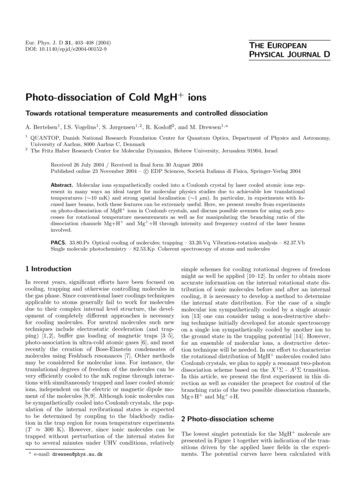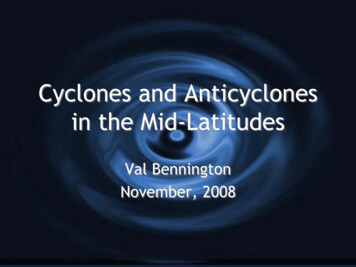
Transcription
Eur. Phys. J. D 31, 403–408 (2004)DOI: 10.1140/epjd/e2004-00152-9THE EUROPEANPHYSICAL JOURNAL DPhoto-dissociation of Cold MgH ionsTowards rotational temperature measurements and controlled dissociationA. Bertelsen1 , I.S. Vogelius1 , S. Jørgensen1,2 , R. Kosloff2 , and M. Drewsen1,a12QUANTOP, Danish National Research Foundation Center for Quantum Optics, Department of Physics and Astronomy,University of Aarhus, 8000 Aarhus C, DenmarkThe Fritz Haber Research Center for Molecular Dynamics, Hebrew University, Jerusalem 91904, IsraelReceived 26 July 2004 / Received in final form 30 August 2004c EDP Sciences, Società Italiana di Fisica, Springer-Verlag 2004Published online 23 November 2004 – Abstract. Molecular ions sympathetically cooled into a Coulomb crystal by laser cooled atomic ions represent in many ways an ideal target for molecular physics studies due to achievable low translationaltemperatures ( 10 mK) and strong spatial localization ( 1 µm). In particular, in experiments with focused laser beams, both these features can be extremely useful. Here, we present results from experimentson photo-dissociation of MgH ions in Coulomb crystals, and discuss possible avenues for using such processes for rotational temperature measurements as well as for manipulating the branching ratio of thedissociation channels Mg H and Mg H through intensity and frequency control of the laser beamsinvolved.PACS. 33.80.Ps Optical cooling of molecules; trapping – 33.20.Vq Vibration-rotation analysis – 82.37.VbSingle molecule photochemistry – 82.53.Kp Coherent spectroscopy of atoms and molecules1 IntroductionIn recent years, significant efforts have been focused oncooling, trapping and otherwise controlling molecules inthe gas phase. Since conventional laser coolings techniquesapplicable to atoms generally fail to work for moleculesdue to their complex internal level structure, the development of completely different approaches is necessaryfor cooling molecules. For neutral molecules such newtechniques include electrostatic deceleration (and trapping) [1,2], buffer gas loading of magnetic traps [3–5],photo-association in ultra-cold atomic gases [6], and mostrecently the creation of Bose-Einstein condensates ofmolecules using Feshbach resonances [7]. Other methodsmay be considered for molecular ions. For instance, thetranslational degrees of freedom of the molecules can bevery efficiently cooled to the mK regime through interactions with simultaneously trapped and laser cooled atomicions, independent on the electric or magnetic dipole moment of the molecules [8,9]. Although ionic molecules canbe sympathetically cooled into Coulomb crystals, the population of the internal rovibrational states is expectedto be determined by coupling to the blackbody radiation in the trap region for room temperature experiments(T 300 K). However, since ionic molecules can betrapped without perturbation of the internal states forup to several minutes under UHV conditions, relativelyae-mail: drewsen@phys.au.dksimple schemes for cooling rotational degrees of freedommight as well be applied [10–12]. In order to obtain moreaccurate information on the internal rotational state distribution of ionic molecules before and after an internalcooling, it is necessary to develop a method to determinethe internal state distribution. For the case of a singlemolecular ion sympathetically cooled by a single atomicion [13] one can consider using a non-destructive shelving technique initially developed for atomic spectroscopyon a single ion sympathetically cooled by another ion tothe ground state in the trapping potential [14]. However,for an ensemble of molecular ions, a destructive detection technique will be needed. In our effort to characterizethe rotational distribution of MgH molecules cooled intoCoulomb crystals, we plan to apply a resonant two-photondissociation scheme based on the X 1 Σ - A1 Σ transition.In this article, we present the first experiment in this direction as well as consider the prospect for control of thebranching ratio of the two possible dissociation channels,Mg H and Mg H.2 Photo-dissociation schemeThe lowest singlet potentials for the MgH molecule arepresented in Figure 1 together with indication of the transitions driven by the applied laser fields in the experiments. The potential curves have been calculated with
404The European Physical Journal D12Potential energy in eV1086εaεb42C1Σ1B Π Mg (3p) H(1s)A1Σεa02Mg(3s ) H Mg (3s) H(1s)X1Σ 201234567Intramolecular distance in Angstrom8Fig. 1. Potential curves for the four lowest lying spin singletelectronic states of MgH (details see Ref. [18]). The symbols a and b represents the electric fields of the laser used in theexperiments.the state average multi-reference self consistent field (MCSCF) method [15,16] using the MOLPRO-package [17].The computational details are presented in reference [18].In the experiments presented here, the field a is created by partially doubling the frequency of field b , andhence their frequencies are always locked to each other.As shown, both of the two dissociation channels Mg H and Mg H are open when both fields are present.3 Experimental techniqueFigure 2 presents a sketch of the experimental set-up. Thedetails of the linear Paul trap used in the experimentshave been given in reference [19]. In short, it consists,like a standard quadrupole mass-filter, of four electrodesmounted so that by applying an rf voltage of the samephase to diagonal electrodes and with a phase shift of180 with respect to the nearest electrodes, a near-idealtwo-dimensional quadrupole field is created in the planeperpendicular to the direction defined by the length of theelectrodes (the trap axis). Each electrode is sub-dividedinto three parts such that a positive dc voltage can be applied to the eight end-pieces. This dc voltage leads to staticconfinement of the ions along the trap axis. By crossingan atomic beam of magnesium with the ns-laser beamsused in the dissociation experiments (see below) in thecenter of the trap, magnesium ions are produced throughnon-resonant photo-ionization processes. The laser beamsapplied to cool the magnesium ions to mK-temperaturesare tuned to the 3s 2 S1/2 –3p 2 P3/2 transition aroundλ 280 nm and propagate along the trap axis (see Fig. 2).These laser beams, focused to a spot size of around onemillimeter, are derived from a frequency doubled CW dyelaser with a typical output power of 20 mW.The fluorescence light emitted during the cooling process is imaged onto an image-intensified CCD-camera.Fig. 2. Sketch of the experimental set-up. The letters on thefigure have the following meanings: W is a window into thevacuum chamber, M1 is a high-power mirror for 560 nm light,Li ’s are lenses to shape the pulsed laser beam with L3 beingused to focus both the 560 nm and the 280 nm light to spot sizesof around 350 µm and 250 µm, respectively, KDP indicates thetype of frequency doubling crystal used to produce the 280 nmlight, SBC represents a Soleil-Babinet compensator used tooptimize the polarization of the 560 nm light for frequencydoubling, M2 is a mirror for the laser cooling light at 280 nm.Not shown on the figure is a CCD-camera situated above theplane of the sketch which monitors fluorescence light from Mg ions in the center of the linear Paul trap.Simply from the spatial distribution of the light recordedin the CCD-images, one is able to deduce the thermodynamic state of the magnesium ion cloud [20,21]. Whenspatial ordered structures appear as an indication of theformation of Coulomb crystals, one can conclude that thetemperature of the ion ensemble is below 100 mK [8].In order to create the MgH molecular ions, afterloading and laser cooling of the magnesium ions into aCoulomb crystalline state, a gas of H2 is leaked into theUHV chamber (background pressure: 1 10 10 Torr) at apartial pressure of 5 10 10 Torr for a few minutes [8].The number of molecular ions produced can continuouslybe monitored by observing the change in the structure ofthe resulting two-component Coulomb crystal [8,19] andhence controlled by closing the leak-valve after a certaintime. It is important to note that when an ensemble ofions with identical charges is cooled into a Coulomb crystal in a linear Paul trap, the densities of the trapped ionspecies are constant and inversely proportional to the massof the ions (see e.g. Ref. [22]). The outer boundary of anion Coulomb crystal consisting of a single ion specie orions species with nearly identical masses is spheroidal inshape [19,23], so it is possible to determine the total number of ions as well as the relative numbers of Mg andMgH ions [19] from images like those shown in Figure 3just by measuring the spatial extension of the Coulombcrystal. Due to the physics of the trap (see, e.g., Ref. [19]),when both Mg and MgH ions are present, the Mg ionsalways segregate near the trap axis in a nearly cylindricalsymmetric volume with the heavier MgH ions arrangedradially outside such that the whole crystal has a nearlyperfect spheroidal shape. An example of this is shown inFigure 3b.
A. Bertelsen et al.: Photo-dissociation of Cold MgH ions405independent of the uncertainty in the transition energiesindicated in reference [24], the uncertainty in the absolutecalibration of the pulsed dye laser and possible frequencyjitter, we have chosen to scan the laser frequency alwaysat a rate of 1 Hz with a scan width that translates intoa photon energy span of 0.95 cm 1 for the a laser field.Reference will always be made to the center energy of thatscan in the following.4 Photo-dissociation resultsFig. 3. (a) CCD-image of a Coulomb crystal with a total of afew thousand Mg ions. (b) CCD-image after the ions in theCoulomb crystal in (a) have been reacting with H2 molecules.Roughly half of the initial fluorescing Mg ions have been converted into non-fluorescing MgH . The dashed lined ellipse illustrates the outer boundary of the Mg –MgH Coulomb crystal. (C) CCD-image after the photo-dissociating laser beamshave been present long enough that all MgH ions have beendissociated. Nearly no non-fluorescing ions are left, provingthat almost all MgH molecules have been dissociated. Thelength of the CCD-images corresponds 950 µm.Likewise, monitoring the changes in the structure ofthe Coulomb crystals when the dissociating laser beamsare present can give information on the photo-dissociationprocesses. Mg ions produced in the photo-dissociationprocesses will be trapped and start fluorescing, while H ions will escape the trapping potential. Hence, we can fromthe CCD-images discriminate between the two dissociation channels depicted in Figure 1, by quantifying the volumes occupied by the Mg and MgH ions.The light used to drive the photo-dissociation processes indicated in Figure 1, comes from a dye laserpumped by a pulsed frequency doubled Nd:YAG laser.The laser field b around 560 nm is directly from the dyelaser, while the laser field a around 280 nm is created bypartially frequency doubling the field b just in front of thevacuum chamber as schematically shown in Figure 2. Thepulsed dye laser system is operated with a repetition rateof 20 Hz with the pulse length of about 8 ns and a maximum pulse energy of about 10 mJ in the interaction zone.The frequency spectrum of each of these pulses is about0.12 cm 1 in width, which is considerably narrower thanthe rotational splittings of the X 1 Σ(ν 0)–A1 Σ(ν 0)transition of the MgH ion, previously measured with anaccuracy of 0.05 cm 1 [24]. Prior to the experiments, thedye laser has been absolute frequency calibrated to betterthan 0.1 cm 1 by optogalvanic spectroscopy on a seriesa neon lines in the neighborhood of 560 nm. In order tolook for resonant effects in the photo-dissociation signalIn the photo-dissociation experiments discussed in thissection, the laser field a is detuned 1.0 cm 1 below theX 1 Σ(ν 0, J 0)–A1 Σ(ν 0, J 1) transition according to reference [24].The images presented in Figure 3 are the examples ofthe Coulomb crystals recorded before the reaction with H2molecules (a), after the reaction (b) and after the ns-laserbeams have been present long enough for all MgH ions todissociate and only fluorescing Mg ions to remain (c). InFigure 3b, the dashed lined ellipse indicates the boundary of the initial Coulomb crystal shown in Figure 3a.By recording sequences of CCD-images with the photodissociating laser beams present, the relative amounts ofthe Mg and MgH ions can be determined from the analysis of the shape and size of the Coulomb crystals in eachimage frame. In Figure 4, the amount of Mg and MgH ions relative to the initial number of Mg ions before reactions are presented for two sets of laser intensities asfunction of the interaction time with the ns-lasers.From both the low and high intensity experiments ofFigure 4 it follows that the MgH ions must dissociatenearly exclusively via the C 1 Σ potential curve into Mgand H since the amount of Mg ions does not changesignificantly during the interaction time. The main difference between Figures 4a and 4b is the time scale onwhich the dissociation takes place. The dissociation rateis observed to have a non-quadratic dependence on theintensity of the field a . This indicates that even thoughthe field a is non-resonant with the X 1 Σ(ν 0, J 0)–A1 Σ(ν 0, J 1) transition, the dissociation probablytakes place via off-resonant excitation to the A1 Σ potential curve. This non-quadratic dependence on the intensity has also been observed in other experiments not presented here. The apparent total lack of dissociation viathe B 1 Π potential curve by the field b is a bit surprisingsince it is energetically allowed. However, theoretical calculations as those presented in the following sub-sectionactually predict that dissociation through the C 1 Σ potential should be more favorable for the laser parameters usedin the experiments.In order to observe resonant effects in the dissociation signal, we have performed experiments with the laserfield a scanned around the resonance of the X 1 Σ(ν 0,J 0)–A1 Σ(ν 0, J 1) and other rotational transitions. Though in a few experiments we have observed signsof resonant behavior in the sense that for some settings ofthe laser frequencies and intensities, dissociation via the
406The European Physical Journal DFig. 4. The amount of Mg and MgH ions relative to the number of Mg ions before the reactions as function of theinteraction time with the dissociation laser beams. The data have been extracted from two different time-series of CCD-imagesrecorded during the presence of the dissociation laser beams. (a) For these data the peak intensities of the two fields a and bwere 1.6 107 W/cm2 and 1.8 107 W/cm2 , respectively, and the frame rate of the CCD-camera 4.7 Hz. (b) Peak intensitiesof the two fields a and b were 4.3 107 W/cm2 and 3.3 107 W/cm2 , respectively, and the frame rate 11.0 Hz. In bothexperiments, the laser field a was detuned 1.0 cm 1 below the X 1 Σ(ν 0, J 0)–A1 Σ(ν 0, J 1) resonance.B 1 Π potential curve was observed, the control of the various experimental parameters such as laser beam profilesand overlap of the two laser fields at the right position inthe trap region made it so-far impossible to quantify suchresults.The next step in the direction of determining the rotational temperature will be to accumulate enough accurateexperimental data for specific laser intensities and detunings, so that we can compare our results with theoreticalmodels taking into account redistribution of the initial rotational population by molecules spontaneously decayingfrom the A1 Σ states to the X 1 Σ states after laser excitation and by the blackbody radiation field present atabout 300 K. From the observed rather slow time scale ofdissociation in the first experiments, it is clear that bothof these mechanisms have to be accounted for with thepresent available laser intensities.5 Control of the dissociation branching ratioIn order to predict interesting parameter regimes for thetwo laser fields a and b , very recently we have set up anumerical simulation where the dynamics of the photodissociation is modeled by solving the time dependentSchrödinger equationi Ψ̃ (r, t) H̃(r)Ψ̃ (r, t), t(1)with the state vector restricted to the four potential curvespresented in Figure 1, and with the Hamiltonian includingthe couplings of the two laser fields a and b illustratedin the same figure.The electric fields are assumed to be constant in amplitude, so that they may be written as1 j (e iωj t eiωj t ), j a, b(2)2where ωj and j are the carrier frequency and the electricfield strength of the laser pulse j , respectively. To eliminate the fast oscillating terms at optical frequencies, therotating wave approximation is employed, such that theHamiltonian can be written [25]see equation belowwhere µi,j (r) is the position dependent electronic transition dipole moment between the electronic states i and j,which have been computed together with the potentialenergy curves in the electronic structure calculation. Theoperator T (1/2Mµ )( 2 / r2 ) is the kinetic energy operator with Mµ being the reduced mass of the diatomicmolecules and Vi (r) the potential energy for the state i.This model is simple. The rotational states are not described, with exception of J 0. Nevertheless, the modelmay give us some guidelines as of interesting parametersfor the frequencies and the intensities.The initial wave function of the magnesium hydrideion, MgH , corresponds to an internal state of the groundelectronic state, X 1 Σ. In the simulations we used the j (t) 1 T VC (r) ωa 0µ (r) a02 CA 1 0T V(r) ωµ(r) 0BBAbb2 H̃ (r) 111 µ(r) µ(r) T V(r)µ(r) ACaABAAXab222 1 00µ(r) T V(r) ωXAaXa2
A. Bertelsen et al.: Photo-dissociation of Cold MgH ions1e91009060 5e8% of total yield in Mg channel70Intensity Ib in Intensity I in W/cm25e71e8aFig. 5. The percentage of the total production yield in thedissociation channel, Mg (3p) H(1s), is shown as a function ofthe laser intensities. The initial state of the molecular systemis represented by the lowest eigenstate on ground electronicstate X 1 Σ(ν 0 and J 0). The intensity is related to theelectric field strength of the electric field by the expressionI 0 c 2 /2, where c is the velocity of light and 0 is theelectric constant.lowest rovibrational state (ν 0 and J 0). Theinitial wave function is propagated in time accordingto the time dependent Schrödinger equation using theChebychev method [26]. The simulation time, or equivalent, the pulse duration of both laser fields, is 5 ps. This ismuch shorter than the pulse durations in the experimentspresented above. This choice has deliberately been madeto investigated the possibility of controlling the branchingratio of the two dissociation channels.The dissociation yields are computed by integratingthe flux of the wave functions for the two potential curvesB 1 Π and C 1 Σ at r 7 Å.In Figure 5, the percentage of the total dissociationyield in the Mg (3p) H(1s) channel via the B 1 Π potential curves is shown as a function of the intensities of thetwo ps-pulses. In the simulations, we have used the experimental values of the laser frequencies, i.e. ωb ωa /2 4.4 eV. As one might expect, we observe that the intensityof the two laser pulses can be used to control the branchingratio between the two dissociation channels. The intensityof the laser pulse enters in the off-diagonal elements ofthe Hamiltonian, which describes the population transfer between the two electronic states. As the intensity increases, the interaction between the molecular system andthe laser pulse increases leading to large population transfer between the two curves. We observe, that the relativeyield of producing magnesium ions increases as the intensity, Ib , increases due to large coupling between the A1 Σand B 1 Π electronic states. As the intensity, Ia , increases,the coupling between the two electronic states A1 Σ andC 1 Σ increases leading to larger yield in the Mg(3s2 ) H dissociation channel.450500550600 650 700 750Wavelength λb in nm800850900Fig. 6. The yield as a function of the wavelength, λb 2πc/ωb , (given in nm) for set 1 the intensities of the two laserpulses are Ia 108 W/cm2 and Ib 109 W/cm2 whereasfor set 2 they take the values Ia 5 106 W/cm2 andIb 2.5 108 W/cm2 .In Figure 6, the percentage of the total dissociationyield into the Mg (3p) H(1s) channel is shown as a function of the laser wavelength, λb , for two different sets ofintensities of the lasers. In both calculations the wavelength of the laser field, a , is chosen to be λa 280 nmas in the experiment. Two peaks are observed in the spectrum, one around 630 nm and another one around 680 nm.At 630 nm the molecule is excited just above the threshold for dissociation on the B 1 Π potential energy curve.In the wavelength window (600–700 nm) the detuning (r) VB 1 Π (r) VA1 Σ (r) ωb is almost zero aroundthe equilibrium bond length for MgH leading to a largepopulation transfer to the B 1 Π-state. Above 630 nm, partof the wave packet is excited below the threshold of thedissociation on the B 1 Π potential energy curve. Since thestate is not an eigenstate, a fraction of the molecular ionswould therefore dissociate.Despite the large difference in time scales between theexperimental and theoretical investigations, the resultspresented in Figures 5 and 6 are qualitatively in agreement with the experimental results in Figures 3 and 4. Theabove model shows that with the frequency, ωb and theintensities (Ia and Ib ) can be used to control the branching ratio of the dissociation channels. The present modelis limited to the lowest rotational state J 0. Futurestudies will extend the dynamical model to include otherrotational states. This extention would lead to a comprehensive comparison with the experimental data.6 OutlookIn the next series of experiments we will vary the intensityof the two fields a and b independently and look for similar control as seen in the theoretical calculations presentedin Figure 5. By favouring the Mg (3p) H(1s) dissociationchannel using this intensity control, we expect to get data
408The European Physical Journal Dfrom which the rotation temperature of our sympathetically cooled molecular ions can be deduced. When thisgoal has been achieved, we will initiate experiments usingincoherent light sources to manipulate the rotational distribution [10,11]. Calculations involving excitation fromspecific rovibrational levels in the ground state will be performed to study the state dependence of the dissociationprocesses. Also non-resonant contributions to the dissociation channels will be investigated, which might eventually lead to a full understanding of the observed nonresonant results of Figures 3 and 4. On a longer time scaleother more complex coherent control mechanisms using,e.g., tailored ps-laser pulses will be investigated.7 ConclusionOn the basis of the dissociation results presented in Figures 3 and 4, we are not yet able to deduce a precise value for an effective rotational temperature of thesympathetically cooled MgH ions. However, by comparing experimental dissociation data with theoretical modelsimulations this should be possible in the near future.Theoretically, we have shown that the branching ratiobetween the two dissociation channels Mg (3p) H andMg(3s2 ) H can be effectively controlled by varying either the intensity of the two lasers involved or the wavelength one of the lasers.SJ is supported by the Carlsberg Foundation. This work hasbeen supported by the European Union in the frame of theCold Molecule TMR network under contract HPRN-CT-200200290 and Israel Science Foundation. The Fritz Haber Centeris supported by the Minerva Gesellschaft für die ForschungGmbH München, Germany. MD acknowledges financial support from the Danish National Research Foundation.References1. H.L. Bethlem, G. Berden, G. Meijer, Phys. Rev. Lett. 83,1558 (1999)2. H.L. Bethlem, G. Meijer, Int. Rev. Phys. Chem. 22, 73(2003)3. J.D. Weinstein, R. deCarvalho, T. Guillet, B. Friedric,J.M. Doyle, Nature 395, 148 (1998)4. J.M. Doyle, B. Friedrich, Nature 401, 749 (1999)5. D. Egorov, D.J. Weinstein, D. Patterson, B. Friedrich, J.M.Doyle, Phys. Rev. A 63, 030501(R) (2001)6. A. Fioretti, D. Comparat, A. Crubellier, O. Dulieu, F.Masnou-Seeuws, P. Pillet, Phys. Rev. Lett. 80, 4402 (1998)7. M. Greiner, C.A. Regal, D.S. Jin, Nature 426, 537 (2003)8. K. Mølhave, M. Drewsen, Phys. Rev. A 62, 011401(R)(2000)9. S. Schiller, C. Lämmerzahl, Phys. Rev. A 68, 053406(2003)10. I.S. Vogelius, L.B. Madsen, M. Drewsen, Phys. Rev. Lett.89, 173003 (2002)11. I.S. Vogelius, L.B. Madsen, M. Drewsen, preprintarXiv:physics/0406100, Phys. Rev. A (to appear)12. I.S. Vogelius, L.B. Madsen, M. Drewsen, preprintarXiv:physics/0406082, J. Phys. B (to appear)13. M. Drewsen, A. Mortensen, R. Martinussen, P. Staanum,J.L. Sørensen, preprint arXiv:physics/0406088, Phys.Rev. Lett. (to appear)14. D.J. Wineland, J.C. Bergquist, J.J. Bollinger, R.E.Drullinger, W.M. Itano, Proc. of the 6th Symposium onFrequency Standards and Metrology (World Scientific, NewJersey, 2002), p. 36115. H.J. Werner, P.J. Knowles, J. Chem. Phys. 89, 1007 (1988)16. P.J. Knowles, H.J. Werner, J. Chem. Phys. 89, 5803 (1988)17. Werner, with contributions from R.D. Amos, Benhardsson,Berning, Celani, Cooper, Deegan, Dobbyn, Eckert, Hampelet al. MOLPRO: A package of ab initio programs, Version2000.118. S. Jørgensen, R. Kosloff, A. Bertelsen, M. Drewsen, inpreparation19. M. Drewsen, I. Jensen, J. Lindballe, N. Nissen, R.Martinussen, A. Mortensen, P. Staanum, D. Voigt, Int. J.Mass Spec. 229, 83 (2003)20. M. Drewsen, C. Brodersen, L. Hornekær, J.S. Hangst, J.P.Schiffer, Phys. Rev. Lett. 81, 2878 (1998)21. L. Hornekær, M. Drewsen, Phys. Rev. A 66, 013412 (2002)22. L. Hornekær, N. Kjærgaard, A.M. Thommesen, M.Drewsen, Phys. Rev. Lett. 86 1994 (2001)23. A. Mortensen, J.J.T. Lindballe, I.S. Jensen, P. Staanum,D. Voigt, M. Drewsen, Phys. Rev. A 69, 042502 (2004)24. W.J. Balfour, Can. Jour. Phys. 50, 1082 (1972)25. A. Hammerich, R. Kosloff, M. Ratner, J. Chem. Phys. 97,6410 (1992)26. R. Kosloff, Annu. Rev. Phys. Chem. 45, 145 (1994)
umes occupied by the Mg and MgH ions. The light used to drive the photo-dissociation pro-cesses indicated in Figure 1, comes from a dye laser pumped by a pulsed frequency doubled Nd:YAG laser. The laser field b around 560 nm is directly from the dye laser, while the laser field a around 280 nm is created by










